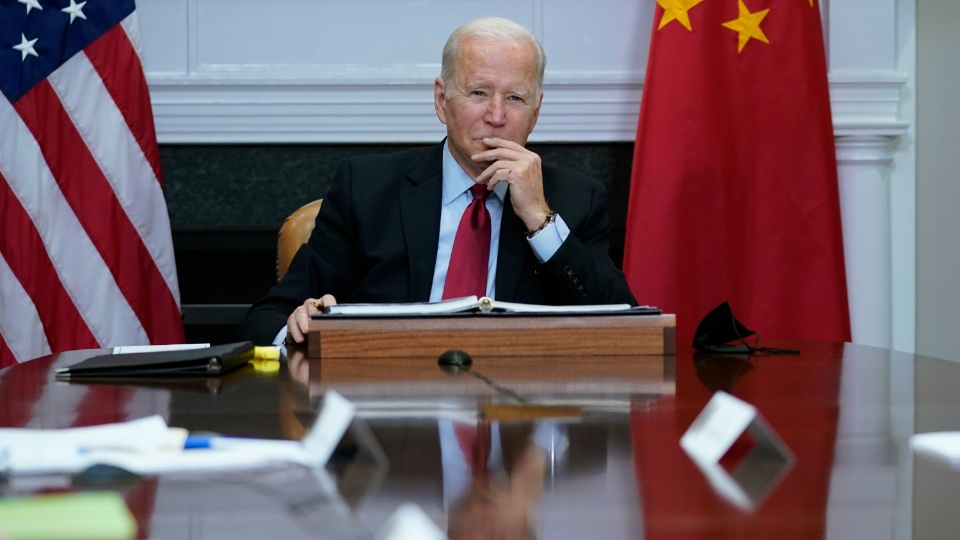
This is the third installment in a three-part series analyzing the set of policies dubbed “Bidenomics” by the Biden administration and the Democratic Party. In the series, author John Bachtell argues the economic initiatives of the Biden presidency are a break from the neoliberal orthodoxy that’s dominated policymaking in Washington for decades. Part one and Part two were published previously.
The climate crisis is accelerating. July was the hottest month ever recorded in human history, and the horrific fires that engulfed parts of the island of Maui are a stark reminder of its deadly toll.
At the same time, the green energy revolution is accelerating faster than anticipated, and in the U.S., renewables will overtake coal by 2025 as the largest source of energy production. In the words of environmentalist Bill McKibbon, “That which heats the planet can be exploited to cool it.”
The passage of the Inflation Reduction Act (IRA) one year ago is boosting the deployment of renewables nationwide at a dizzying rate. The IRA is a central pillar of the new economic and social policies dubbed “Bidenomics.”
Bidenomics aims to replace neoliberal “trickle-down” and union-busting policies that dominated economics over the past four decades with a national industrial policy to guide a green energy transition while empowering workers and addressing the economic inequality and wreckage left by neoliberalism.
Bidenomics encompasses four significant pieces of legislation: The IRA, the American Rescue Plan (ARP), the Infrastructure and Investment Jobs Act (IIJA), and the CHIPS and Science Act (CHIPS). They do not equal the Green New Deal, which scientists agree is needed to address the climate crisis. Opposition from the fossil fuel industry, the entire GOP, and right-of-center Democrats forced Biden and Democratic Congressional leaders to reduce their scale and accept painful concessions. Nonetheless, their passage was a historic victory.

Bidenomics offers a new terrain of struggle for the pro-democracy, pro-environment majority to contest the scale, scope, and speed of decarbonizing the economy and winning political, social, and economic equality.
The anti-China angle
But the American people need to weigh in on another critical aspect of these policies—the economic protectionism and “strategic competition” with China that frame them. The outcome will determine whether the global green transition is peaceful, cooperative, democratic, or fraught with conflict and inequality.
“How did disparate groups come together to support the IRA?” asked Tim Sahay, Senior Policy Manager, Green New Deal Network. “Nothing brings disparate groups together like a common enemy—the green industrial policy is wrapped in anti-China rhetoric—which is the one issue, whether national security hawks, trade hawks, deficit hawks…they wholeheartedly agree on being anti-China.”
This is Bidenomics’ most contentious, troubling, and potentially dangerous aspect. Anti-China economic protectionism promotes the most hawkish voices for confronting China economically and militarily. Dynamics are in motion that could spiral out of control, including into an armed conflict, despite recent efforts to tamp down differences.
The Biden administration’s efforts to build a global anti-China coalition are full of limitations and contradictions, but they’re ultimately bound to fail. China has plenty of willing international trading partners, including in the EU and Global South, and can overcome whatever restrictions the U.S. may impose.
Now is the time for greater global cooperation, especially between the two leading economies, to accelerate the green energy transition and address other urgent challenges. Ironically, cooperation on climate is the best path for stable relations, highlighted by the recent visit to China by special climate envoy John Kerry.
Impact of U.S. – China trade
China’s policy of “opening up” to global trade and investment that was initiated in 1978 was decisive for accumulating the capital needed to transform from underdevelopment to a modern industrial powerhouse in 40 years. China lifted 700 million people out of extreme poverty and built a modern national infrastructure.
Enormous environmental costs accompanied these achievements, of course. China offered low labor costs and still had scant ecological protections, so foreign corporations offshored millions of jobs and greenhouse gas emissions. China became the largest aggregate emitter of global warming greenhouse gases, although the U.S. economy, to this day, remains among the largest emitters per capita and the largest historically.

The U.S. lost 3.7 million manufacturing jobs to China beginning in 2001 when that country joined the World Trade Organization. According to one study, roughly 60% of manufacturing job losses in the U.S. were due to competition with China. Manufacturing job loss continued until 2010, but the impacted working-class communities, primarily in the Midwest and South, haven’t recovered.
Unemployed workers felt abandoned, and the federal government did little to assist them and their communities. Meanwhile, Republicans cut the social safety net to the bone, and government policy helped facilitate capital investment in China.
The upheaval had devastating political consequences. Deindustrialization meant the loss of unions, the last organizations that shaped workers’ collective political outlook. The GOP and MAGA fascists filled the void by misdirecting these working-class communities’ anger, fear, and insecurity. They made inroads among white workers with racist scapegoating, spawning the political crisis of Trumpism.
Bidenomics aims to address this economic devastation and political crisis by offering a forward-looking environmental, economic, and social policy, rebuilding U.S. manufacturing, and empowering workers while carrying out the green energy revolution.
Global competition
Competition between global or regional powers is inherent to the world economy. And China’s rise and consolidation of its own economic and geographic sphere of influence brought it into increasing competition with U.S. economic hegemony. U.S. capitalist elites, who prized China as a low-wage zone for investment and sought to integrate China into the global economy, did an about-face as China came to dominate critical economic and technical sectors.
They now see China, a socialist-oriented economy with massive state investment in industry, infrastructure, and R&D, as a “strategic competitor.” U.S. capitalist elites see their interests threatened, along with their global hegemony.
According to Ted Fertik, Working Families Party Senior Strategist, once it became apparent a green energy transition was necessary, these capitalist elites realized China was dominating critical industries needed for green energy production, including every part of the solar panel supply chain. They feared China would freeze U.S. capital out of the global market.
Indeed, China already leads the world in renewable energy and expects to double capacity by 2025, five years ahead of schedule. China’s solar power capacity is larger than the rest of the world combined. Between 2019 and 2024, China will account for 40% of global renewable capacity expansion, despite increasing coal consumption.
China made enormous investments in solar production, allowing Chinese companies to reduce costs by 80% and dominate approximately 80% of the global solar production process. In 2022, the International Energy Agency (IEA) estimated China would produce 95% of the world’s polysilicon, ingot, and wafer, a key ingredient in crystalline silicon solar panels that make up 95% of solar panels.
Regarding the EV battery supply chain, “China has a 10- to 15-year head start on the rest of the world,” said analyst Chris Berry with House Mountain Partners. China accounts for 50-60% of the global EV market.
From this angle, policymakers designed Bidenomics to accelerate the establishment of a U.S.-based renewable energy sector for export and block China’s ability to compete by denying China access to advanced microchips, quantum computing, and Artificial Intelligence (AI) technology.
But as the COVID-19 pandemic made plain, the concentration of production in China also created a supply chain crisis that deeply shook the U.S. economy. Bidenomics also addresses this real vulnerability by substantially reshoring production and rebuilding the U.S. manufacturing base to avoid this crisis in the future.
The IEA warned China’s domination over the global production of solar panels could hamper the global transition to green energy in the event of a supply chain crisis. “Ensuring a secure transition to net-zero emissions will require increased efforts to expand & diversify global production of solar panels,” the IEA said, without considering the U.S.- China rivalry.
Is a peaceful competition possible?
Decarbonizing the global economy and reaching net-zero greenhouse gas emissions by 2050 rests heavily on peaceful competition between the U.S. and China and the ability of the world’s two biggest polluters to carry out green energy revolutions.

Some Democratic elected officials, progressives, and environmentalists are alarmed that protectionist policies aimed at China could cement a new Cold War or, worse, an armed conflict that threatens the world. They urge the Biden administration to pursue multilateralism, diplomacy, negotiations, and global cooperation in the green energy transition.
From this standpoint, anti-China economic nationalism runs counter to cooperation and marshaling the world’s material and human resources to meet the challenge.
To be sure, the Biden administration has declared it opposes “decoupling” the two economies. Complete decoupling is unrealistic anyway, given existing economic integration and trade, making the idea of a new Cold War a somewhat poor analogy since the U.S. and USSR had practically no trade relations.
However, the administration supports “de-risking” supply chains critical to the U.S. economy by reshoring or moving them to a third country. Again, their vulnerability became starkly apparent during the worldwide pandemic.
Still, trade and investment have taken a hit since Trump placed tariffs on two-thirds of Chinese-made goods—tariffs which have continued under the Biden administration. U.S. imports from China declined by 24% in the first five months of 2023. Trade has shifted to other Asian countries, and Mexico is now the largest source of U.S. imports. Foreign investment in new factories in China is now one-fifth of what it was in 2010.
The U.S. trade restrictions with China contained in the export control regulations issued on Oct. 7 last year target advanced semiconductors used in AI, quantum computing, software development, and chip production tools. Prior restrictions prevented U.S. technology from being used in military technology. The new rules cover every sector and limit U.S. investment in Chinese technology sectors.
The goal is to block the development of AI chips and degrade Chinese technological development. “If you’d told me about these rules five years ago, I would’ve told you that’s an act of war—we’d have to be at war,” said C.J. Muse, a semiconductor analyst at Evercore ISI.
However, U.S. corporations still have enormous investments in China and are pushing back. Leading microchip manufacturers met with Biden administration officials on July 17 to argue against further microchip trade and investment restrictions with China, the largest global purchaser.
China claims the U.S. is sabotaging its economic development to maintain economic and military hegemony. Critics contend denying China access to semiconductor chips and other technology is short-sighted because China will develop them eventually, but the cleavage between the nations will last.
Critical minerals
The green transition also highlights the need for international cooperation to extract and process critical minerals needed in producing solar, wind, EVs, and batteries. According to the International Energy Agency, “A typical electric car requires six times the mineral inputs of a conventional car, and an onshore wind plant requires nine times more mineral resources than a gas-fired plant.”
There is plenty of supply of these minerals: copper, rare earth elements, lithium, cobalt, and nickel. Still, they are highly concentrated in certain countries, leaving supplies vulnerable to disruptions that could threaten a clean energy transition. And mining corporations from China, the U.S., and other advanced capitalist economies are scrambling to dominate mineral markets from critical countries.
For example, the Democratic Republic of Congo has 95% of all the world’s cobalt; China has the most graphite and rare earth elements; Australia produces the most lithium; South Africa has the most platinum; and Indonesia, Philippines, and Russia collectively have the most nickel. The U.S. needs access to more cobalt and nickel to manufacture green energy components.
Bidenomics calls for critical minerals to be U.S.-sourced or obtained through countries with which it has free trade agreements. However, notorious past practices of U.S.-based mining companies and U.S. economic protectionism toward China raise questions about sharing these critical minerals with the global community.
The Critical Minerals Summit will take place in South Africa in October. U.S. policymakers fear countries in the Global South could form cartels around these minerals as OPEC did with oil, a reason why the U.S. pursued destructive fracking to achieve energy independence. Such thinking doesn’t bode well for cooperation and solidarity with the Global South to transition to green energy.
The global community must guarantee the rights and interests of developing nations and Indigenous communities where a lot of critical minerals reside.
U.S. militarism and global conflict
The race to achieve global net-zero emissions by 2050 occurs in a complex and increasingly dangerous international context. Russia’s illegal invasion and annexation of part of Ukraine, its brutal destruction, ecocide, and its effect on global energy and grain markets compound global tensions.
The Russia-Ukraine war, regardless of how one understands its causes, has resulted in increased military budgets across Europe, more countries seeking to join NATO, and growing international instability and polarization. The Russian invasion and the anti-China economic nationalism make the job of peace and environmental justice forces much harder, especially in fighting for demilitarization and dissolving NATO and other military alliances.
At the same time, accelerating the transition to net zero requires marshaling every social, economic, and human resource possible. It involves a demilitarization of the economy and a massive redirect of military funding for the green transition, building resilient and adaptable infrastructure, and international solidarity with the green energy transition in the Global South.
The $1 trillion U.S. military budget is larger than the military budgets of the following ten countries combined. The military-industrial complex (MIC), including the top weapons manufacturers, is deeply embedded in the U.S. economy, with funding and jobs impacting every congressional district. The MIC has a powerful influence on politics, ideology, society, and culture.
The U.S. military is also the largest global institutional consumer of fossil fuels and the largest producer of greenhouse gas emissions. Military installations, including 800 overseas bases, account for about 40% of DOD greenhouse gas emissions. Since 2001, the DOD has been responsible for nearly 80% of all U.S. government energy needs.

Historically, the interests of the military-industrial complex intersect with the fossil fuel industry. A significant justification for the U.S. global military presence is protecting oil supplies in the Persian Gulf as the lifeblood of U.S. capitalism. And these sections of capital fund the extreme right and MAGA movement.
So, the “threat” from China is a new rationale for maintaining high military spending and the rising national security risks stemming from the climate crisis, including conflict over resources, water, food insecurity, climate refugees, and political instability.
An accelerated global transition to green energy and greater cooperation around all aspects of the climate crisis is better for the planet and cheaper than maintaining a far-flung military operation while liquidating the power and influence of the most reactionary sections of U.S. capital.
Urgent need for international cooperation
The challenges from the climate crisis grow in scope and scale daily. For example, the U.N. estimates 500 million people will become climate refugees, including tens of millions in the U.S. Heightened cooperation and solidarity are needed to respond to climate-related disasters, build resilient infrastructure, resettle climate refugees, and provide food, water, shelter, and medical care.
Saving the planet can only be solved through global cooperation and peaceful co-existence, respect for national sovereignty, territorial integrity, and elevating negotiation and diplomacy over war. We must insist on building a new just, democratic global order that works through international institutions like the United Nations and upholds the UN Charter.
In the face of an existential crisis, we must insist on human solidarity: equality of nations, mutually beneficial relations, assistance to developing economies by wealthy ones, and sharing of resources, science, technology, and critical minerals in the green transition.
The transition to green energy should occur in an international climate of peace and democratization, not one fraught with conflict. Instead of blocking China’s development, the U.S. should embrace China as an equal partner in the global trade system, cooperate in mutually beneficial ways, and solve disputes through negotiation and diplomacy.
Despite its flaws, “Bidenomics” is an essential first step in the green energy transition. Building on it starts by re-electing Biden and expanding Democratic Congressional majorities in 2024. The pro-democracy, pro-environment alliance can further protect, develop, deepen, and democratize the green transition by crushing MAGA. And it can reframe U.S. foreign policy toward environmental justice, peace and demilitarization, international cooperation, and solidarity.
This article reflects the opinions of its author.
We hope you appreciated this article. At People’s World, we believe news and information should be free and accessible to all, but we need your help. Our journalism is free of corporate influence and paywalls because we are totally reader-supported. Only you, our readers and supporters, make this possible. If you enjoy reading People’s World and the stories we bring you, please support our work by donating or becoming a monthly sustainer today. Thank you!










